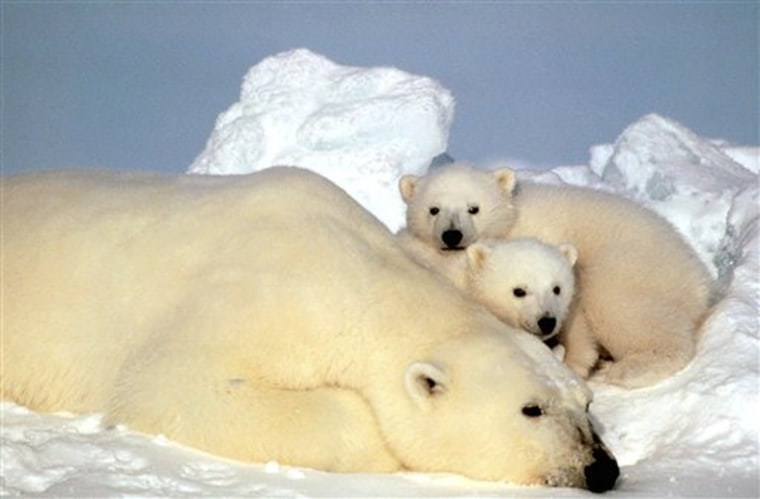Polar bear cubs in Alaska’s Beaufort Sea are much less likely to survive compared to 20 years ago, probably due to melting sea ice caused by global warming, according to a new federal government study.
Published by the U.S. Geological Survey, the study estimated that only 43 percent of polar bear cubs in the southern Beaufort Sea survived their first year during the past five years, compared to a 65 percent survival rate in the late 1980s and early 1990s.
“The changes in survival of cubs are very dramatic,” said co-author Steven Amstrup, polar bear project leader for the USGS Alaska Science Center.
The falling survival rate comes as a warming climate has melted much of the sea ice off Alaska’s northern coast, limiting polar bears from hunting for food at the ice’s edge.
“The things we’re observing are consistent with a population that is undergoing nutritional stress,” said Amstrup. “We can’t say definitively it’s because of changes in the sea ice, but we don’t know what else it would be.”
Adult males getting smaller
The study of polar bears in the south Beaufort Sea, which spans the northern coasts of Alaska and western Canada, also found that adult males weigh less and have smaller skulls than those captured and measured two decades ago.
"Such changes in physical stature may suggest different impacts of reduced summer sea ice on adult male and female polar bears," the study said.
In spring, adult males often forgo foraging opportunities and focus on finding females for mating, the study said. Entering the summer in relatively poorer nutritional shape, they may be more vulnerable to summer sea ice retreat, which can separate polar bears from the most productive foraging habit, the study said.
Reduced foraging opportunity for adult females usually is first reflected in poorer survival of their young, the study said.
The study warns that the decline in cub survival and the smaller adult males are the same conditions that preceded a decline in the polar bears of western Hudson Bay, Canada, where the population dropped 22 percent in 17 years.
The report stopped short of saying the Beaufort Sea polar bear population, one of two in Alaska, had declined.
However, "significant changes in cub survival and physical stature must ultimately have population level effects," the report concluded.
The report estimates the Beaufort Sea polar bear population at 1,526, down from a previous estimate of 1,800 bears. That would be a 15 percent decline, but researchers said the current study used different methods of counting.
The Beaufort Sea bears is one of two Alaska stocks. The other is the Bering-Chukchi stock off Alaska's northwest coast, a population shared with Russia.
Petition for protected status
Advocates seeking protections for U.S. polar bears say the report proves their point.
"It's just another example of seeing all of the impacts that scientists have previously predicted coming to pass," said Kassie Siegel of the Center for Biological Diversity in Joshua Tree, Calif. Siegal is the lead author of the petition seeking to list polar bears as threatened under the Endangered Species Act.
"The Grim Reaper of global warming is now clearly killing polar bear cubs," said Deborah Williams, president of Alaska Conservation Solutions, an Anchorage-based group aimed at halting climate change. "This study should be interpreted as a cry from the North to reduce greenhouse gases."
Polar bears are classified as marine mammals because they spend much of their lives on sea ice. The listing petition claims that polar bears are threatened because of drastic declines in ocean ice due to global warming. A decision by the U.S. Fish and Wildlife Service on listing America's polar bears as threatened is due by Dec. 27.
Siegel said the effects of shrinking sea ice are occurring exactly as summarized by the scientists quoted in her group's listing petition.
"Only it's happening sooner than they thought," she said.
Drownings, starvation seen
Several recent observed deaths were directly related to sea ice retreat or changes in food availability associated with sea ice retreat.
In autumn 2004, four polar bears drowned trying to swim from short and distant pack ice. During winter and spring 2004, researchers recorded evidence of three polar bears hunting, killing and eating other polar bears.
Last spring, three adult females and one yearling were found dead. Three of the bears had depleted their lipid stores, an indication they had starved. The fourth, one of the adult females, was largely scavenged, and cause of death could not be determined. However, her death was unusual, the study said, because prime-age females in the past have had high survival rates.
"These anecdotal observations, in combination with both the changes in survival of young and in physical stature reported here, suggest mechanisms by which a changing sea ice environment can affect polar bear demographics and the status of populations," the report said.
The USGS study is online at pubs.water.usgs.gov/ofr20061337.
